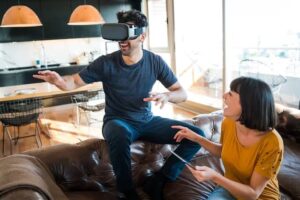Discover the fascinating world of augmented reality (AR) with 8th Wall, a cutting-edge web-based platform designed for creating immersive AR experiences. Whether you’re a developer, artist, or enthusiast, 8th Wall offers the tools and flexibility to bring your AR visions to life. This guide will walk you through the entire process, from initial setup to final deployment, demystifying the complexities of AR development and empowering you with the knowledge to create captivating experiences that engage and inspire.
Setting Up an Account on 8th Wall: The First Steps
Begin your AR journey with a solid foundation by setting up an account on 8th Wall. Visit 8th Wall’s website and sign up for free. You’ll need to provide a valid email address and create a secure password. This step is crucial as it grants you access to a wide array of tools and features offered by 8th Wall, including the developer console, project templates, and extensive resources. It’s the gateway to a user-friendly environment where your creativity in AR can truly flourish.
Navigating the Developer Console: Central Hub for AR Projects
The developer console on the 8th Wall is your command center for creating and managing AR projects. After logging in, you’ll find yourself in an intuitive interface designed to streamline your workflow. The console allows you to create new projects, manage existing ones, access analytics, and explore a range of functionalities essential for AR development. This central hub is where your ideas take shape, and you can monitor the progress of your projects, making adjustments as needed to ensure optimal performance and user engagement.
Starting a New Project: Laying the Foundation
Initiating a new project on the 8th Wall is the first step in bringing your AR vision to life. Click on the “New Project” button in the developer console and select the “Web” option. Assign a unique name to your project – this will be its identity throughout the development process. Creating a project lays the groundwork for your AR experience, allowing you to build upon a solid base and gradually add layers of interactivity and creativity that define your AR application.
Selecting the Right Template: Tailoring Your AR Experience
8th Wall offers a variety of project templates to kickstart your AR journey. These templates are designed to cater to different AR experiences, such as image tracking, face filters, or world effects. Choosing the right template is pivotal, as it shapes the fundamental interaction of your AR experience. Whether you’re aiming for an engaging marketing campaign, an educational tool, or an interactive art installation, the templates provide a starting point that you can customize to align with your creative vision.
Customizing Project Settings: Fine-Tuning for Success
In the project settings, you have the freedom to tailor various aspects of your AR experience. This includes enabling location services for geospatial AR, customizing the app icon for brand consistency, or setting up a unique splash screen to captivate users upon launch. These settings are instrumental in defining the user experience, allowing you to fine-tune your AR application to meet specific needs and objectives. Proper configuration ensures that your AR project not only functions seamlessly but also resonates with your target audience.
Downloading and Managing Project Files: Organizing Your AR Toolkit
Once you’ve set up your project, download the project files from 8th Wall. These files typically include HTML, JavaScript, and CSS files, forming the backbone of your AR experience. Organizing these files in a local directory on your computer is crucial for efficient development. It’s where you’ll spend most of your time coding and testing, making it essential to have a well-structured and accessible project folder. This organization is key to a smooth development process, allowing for easy navigation and modifications as your project evolves.
Personalizing Your Project: Coding the AR Experience
Editing your project is where your creativity comes into play. Open the project folder and start personalizing the AR experience by editing files like “index.html,” “app.js,” and “styles.css.” This is where you breathe life into your project, infusing it with interactive elements, custom designs, and unique functionalities. Utilize coding editors like Visual Studio Code or Sublime Text to write and modify code, transforming the basic template into a bespoke AR experience that aligns with your vision and goals.
Incorporating Diverse Media Elements: Enriching the AR Realm
To create a truly immersive AR experience, include various multimedia elements such as 3D models, images, audio files, and animations. These assets add depth and engagement to your AR project, making it more appealing and interactive. Formats like GLTF or OBJ are commonly used for 3D models, ensuring compatibility and smooth performance. Thoughtfully selecting and integrating these elements is vital to creating an AR experience that not only functions well but also captivates and delights users.
Local Testing: Ensuring Flawless Functionality
Testing your AR project locally is a critical step in the development process. Use a local web server, such as the “Web Server for Chrome” extension, to test the functionality and interactivity of your AR experience. This allows you to identify and address any issues or glitches before deploying your project publicly. Local testing ensures that your AR application performs as intended across different devices and browsers, providing a seamless experience for users.
Cloud Deployment: Making Your AR Experience Accessible
To make your AR project accessible to the public, deploy it on a cloud platform. Choose a reliable hosting provider like Amazon S3, Netlify, or Firebase Hosting to upload your project files and assets. Cloud deployment is crucial for making your AR experience available to a wider audience, ensuring that it can be accessed from anywhere, at any time. This step marks the transition from development to public availability, allowing users worldwide to interact with your AR creation.
Finalizing on the Console: Updating Your Live Project
After deploying your project, return to the 8th Wall developer console to update the project settings with the URL of your hosted AR experience. This ensures that your project is linked to the correct web address, making it accessible to users. Updating the console with your live project URL is a crucial final step in the development process, as it officially launches your AR experience into the digital world.
Sharing Your AR Creation: Expanding Reach and Impact
Once your AR project is live, share it with your audience. Whether embedding it on your website, sharing the URL, or using QR codes for easy access, the goal is to reach as many users as possible. This is your opportunity to showcase your work, gather feedback, and see the real-world impact of your AR experience. Sharing your project is not just about exposure; it’s about creating connections, sparking curiosity, and offering new ways of interacting with the digital world.
Comparative Analysis: 8th Wall vs. Other AR Platforms
| Feature | 8th Wall | Other AR Platforms |
|---|---|---|
| Web-Based Accessibility | Yes | Varies |
| Ease of Use | User-friendly interface | Varies |
| Customization | High flexibility | Varies |
| Template Availability | Wide range of templates | Varies |
| Deployment Options | Cloud hosting | Varies |
| Local Testing | Supported | Varies |
| Asset Integration | Extensive support | Varies |
| User Engagement | Highly interactive | Varies |
Video Guide
To answer all your questions, we have prepared a video for you. Enjoy watching it!
Conclusion
Embark on your journey with 8th Wall and unlock the potential of augmented reality. This comprehensive guide has equipped you with the knowledge and tools to create captivating AR experiences. Whether you’re a seasoned developer or new to AR, 8th Wall offers a platform where your creativity can thrive.


Average Rating